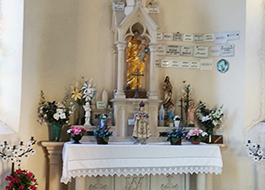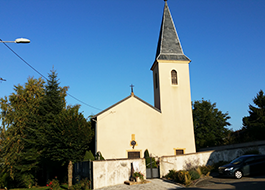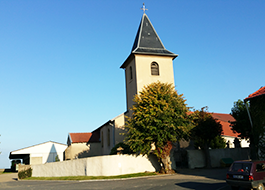Saint-Jure
Durée visite : 40 minutes
Moyen : Pédestre
Le village dépendait du pays messin. C’était, depuis au moins le XIe siècle, une entité territoriale formée par les villages aux alentours de Metz. Elle relevait en partie de la ville de Metz et en partie du temporel de l’évêché. Saint-Jure était fief de l’évêché tenu par les nobles familles messines. Il appartint au bailliage de Metz. Celui-ci était une entité administrative des Trois-Evêchés. Elle a existée de 1634 à 1790. En 1813, Ressaincourt et Alémont sont rattachés à Saint-Jure.
The village depended on the Metz region. It was, since at least the 11th century, a territorial entity formed by the villages around Metz. It was part of the city of Metz and part of the bishopric. Saint-Jure was the fiefdom of the bishopric held by the noble families of Metz. It belonged to the bailiwick of Metz. This was an administrative entity of the Trois-Evêchés. It existed from 1634 to 1790. In 1813, Ressaincourt and Alémont were attached to Saint-Jure.
Das Dorf war abhängig von der Region Metz. Es war seit mindestens dem 11. Jahrhundert eine territoriale Einheit, die von den Dörfern um Metz gebildet wurde. Es war Teil der Stadt Metz und Teil des Bistums. Saint-Jure war das Lehen des Bistums der Adelsfamilien von Metz. Es gehörte der Vogtei von Metz. Dies war eine Verwaltungseinheit der Trois-Evêchés. Es bestand von 1634 bis 1790. 1813 wurden Ressaincourt und Alémont an Saint-Jure angeschlossen.

Le village dépendait du pays messin. C’était, depuis au moins le XIe siècle, une entité territoriale formée par les villages aux alentours de Metz. Elle relevait en partie de la ville de Metz et en partie du temporel de l’évêché. Saint-Jure était fief de l’évêché tenu par les nobles familles messines. Il appartint au bailliage de Metz. Celui-ci était une entité administrative des Trois-Evêchés. Elle a existée de 1634 à 1790. En 1813, Ressaincourt et Alémont sont rattachés à Saint-Jure.
Chevronné Or and Azure, with the fleur-de-lis of silver from which are born two palms Vert debruising over the whole.
The background constitutes the arms of Saulnois, part of the Pays Metz to which Saint-Jure belonged. The fleur-de-lis, emblem of the abbey of Saint-Vincent de Metz, reminds us that the abbey owned the village lordship until the Revolution.
Chevronné Or und Azure, mit der Lilie aus Silber, aus der zwei Palmen Vert hervorgehen, die über das Ganze schwächen.
Der Hintergrund bildet das Wappen von Saulnois, einem Teil des Pays Metz, zu dem Saint-Jure gehörte. Die Lilie, Wahrzeichen der Abtei von Saint-Vincent de Metz, erinnert uns daran, dass die Abtei bis zur Revolution die Herrschaft über das Dorf hatte.

Lés palés d’Olémont = les pelés d’Alément.
» Pelés » est un terme injurieux qui s’applique à une personne dont la tête est dégarnie de cheveux. On donne aussi ce qualificatif à des gens dont on ne fait pas grand cas. On dit, par exemple, il y avait là trois teigneux et un pelé, c’est-à-dire pas grand’ chose. Indiquons aussi que selon la symptomatologie du Moyen âge, cette lésion était toujours considérée comme un des seize signes de la lèpre. Pour adoucir leur peau, les pauvres » pelés » y appliquaient une décoction de feuilles de lierre, usage qui persistait encore jusqu’au milieu du XIXe siècle chez les cagots dans le Sud-Ouest de notre pays. Il est probable que beaucoup d’habitants de ce petit village ont été éprouvés par cette maladie de la peau, assez fréquente dans la région au XVIIe siècle.
Réf. de Westphalen, Petit Dictionnaire, p. 676 – Zéliqzon, Dictionnaire, p. 490
Lés palés d’Olémont = pelés d’Alément.
« Pele » is an offensive term that applies to a person whose head is bald of hair. We also give this qualifier to people of whom we do not pay much attention. They say, for example, there were three scabies and one peeled, that is to say, not much. Let us also indicate that according to the symptoms of the Middle Ages, this lesion was always considered as one of the sixteen signs of leprosy. To soften their skin, the poor « peeled » applied a decoction of ivy leaves, a use that still persisted until the middle of the nineteenth century among cagots in the southwest of our country. It is likely that many inhabitants of this small village were affected by this skin disease, quite common in the region in the 17th century.
Ref. de Westphalen, Small Dictionary, p. 676 – Zéliqzon, Dictionary, p. 490
Lés palés d’Olémont = pelés d’Alément.
« Pelés » ist ein beleidigender Begriff, der für eine Person gilt
dessen Kopf ist nackt. Wir geben dieses Qualifikationsmerkmal auch an Personen weiter, denen wir nicht viel Aufmerksamkeit schenken. Sie sagen zum Beispiel, es gab drei Krätze und eine geschälte, das heißt nicht viel. Lassen Sie uns auch darauf hinweisen, dass diese Läsion nach den Symptomen des Mittelalters immer als eines der 16 Anzeichen von Lepra angesehen wurde. Um ihre Haut zu erweichen, trugen die Armen « geschält » eine Abkochung von Efeublättern auf, eine Verwendung, die bis Mitte des neunzehnten Jahrhunderts unter den Cagots im Südwesten unseres Landes noch bestand. Es ist wahrscheinlich, dass viele Einwohner dieses kleinen Dorfes von dieser Hautkrankheit betroffen waren, die im 17. Jahrhundert in der Region weit verbreitet war.
Ref. de Westphalen, Kleines Wörterbuch, p. 676 – Zéliqzon, Dictionary, p. 490
Les points de visites
.
La chapelle Notre-Dame est de style néo-gothique. Elle date de 1929. Elle abrite une Vierge à l’Enfant du XVIIIe siècle. On y admire un curieux buste de pierre peinte de saint Maclou. Saint Maclou, ou saint Malo, est l’un des sept fondateurs de la Bretagne continentale. Il serait originaire du Gwent, au Pays de Galles. Il devient évêque d’Aleth, situé prés du site du futur Saint-Malo. Il est mort vers 620.
The Notre-Dame chapel is neo-Gothic in style. It dates from 1929. It houses an 18th century Madonna and Child. We admire a curious painted stone bust of Saint Maclou. Saint Maclou, or Saint Malo, is one of the seven founders of mainland Brittany. He is said to be from Gwent, Wales. He becomes Bishop of Aleth, located near the site of the future Saint-Malo. He died around 620.
Die Notre-Dame-Kapelle ist neugotisch. Es stammt aus dem Jahr 1929. Es beherbergt eine Jungfrau und ein Kind aus dem 18. Jahrhundert. Wir bewundern eine merkwürdige bemalte Steinbüste von Saint Maclou. Saint Maclou oder Saint Malo ist einer der sieben Gründer des bretonischen Festlandes. Er soll aus Gwent, Wales, stammen. Er wird Bischof von Aleth, der sich in der Nähe des zukünftigen Saint-Malo befindet. Er starb um 620.
.
.
Son nom rappelle l’ancien nom du village au XIVe siècle, Villa sancti Georgii. Son chœur date du XIVe siècle, la nef du XVIIe siècle. Les chapiteaux sont des XIIIe et XIVe siècles. Elle abrite une Vierge à l’Enfant des XVIe et XVIIe siècles. Voici la légende de ce saint. Georges, officier dans l’armée romaine, arrive dans une ville terrorisée par un terrible dragon. Celui-ci exige des habitants un tribut quotidien de deux jeunes gens tirés au sort. Georges est là le jour où le sort tombe sur la fille du roi. Georges engage avec le dragon un combat féroce; avec l’aide du Christ, il finit par triompher. Cela rappelle bien-sûr le mythe de Thésée et du Minotaure.
Its name recalls the old name of the village in the 14th century, Villa sancti Georgii. Its choir dates from the 14th century, the nave from the 17th century. The capitals are from the 13th and 14th centuries. It houses a Virgin and Child from the 16th and 17th centuries. Here is the legend of this saint. George, an officer in the Roman army, arrives in a city terrorized by a terrible dragon. He demanded from the inhabitants a daily tribute of two young men drawn by lot. George is there on the day fate falls on the king’s daughter. George engages in a fierce fight with the dragon; with Christ’s help, he eventually triumphed. This is of course reminiscent of the myth of Theseus and the Minotaur.
Sein Name erinnert an den alten Namen des Dorfes im 14. Jahrhundert, Villa sancti Georgii. Sein Chor stammt aus dem 14. Jahrhundert, das Kirchenschiff aus dem 17. Jahrhundert. Die Hauptstädte stammen aus dem 13. und 14. Jahrhundert. Es beherbergt eine Jungfrau und ein Kind aus dem 16. und 17. Jahrhundert. Hier ist die Legende dieses Heiligen. Georg, ein Offizier der römischen Armee, kommt in einer Stadt an, die von einem schrecklichen Drachen terrorisiert wird. Er verlangte von den Einwohnern eine tägliche Hommage an zwei junge Männer, die durch das Los gezogen wurden. George ist an dem Tag dort, an dem das Schicksal auf die Königstochter fällt. George verwickelt sich in einen erbitterten Kampf mit dem Drachen; mit Christi Hilfe triumphierte er schließlich. Das erinnert natürlich an den Mythos von Theseus und dem Minotaurus.
.
Cette austère édifice abrite un chœur de 1518. Une croix et une statue datent du XVe siècle. Hubert de Liège est né à Toulouse entre 656 et 658. Il est mort à Fouron-le-Comte en 727. Il est membre de la haute aristocratie franque. C’était un chasseur acharné. La légende rapporte qu’il n’avait pu résister à sa passion un Vendredi Saint. Hubert n’avait trouvé personne pour l’accompagner. À cette occasion, il se trouva face à un cerf extraordinaire. En effet, celui-ci était blanc. Il portait une croix lumineuse au milieu de ses bois. Hubert se mit à pourchasser le cerf. Mais celui-ci parvenait toujours à le distancer, sans pour autant se fatiguer. Ce n’est qu’au bout d’un long moment que l’animal s’arrêta. Une voix tonna dans le ciel en s’adressant à Hubert en ces termes :
Hubert ! Hubert ! Jusqu’à quand poursuivras-tu les bêtes dans les forêts ? Jusqu’à quand cette vaine passion te fera-t-elle oublier le salut de ton âme ?
Hubert fut bouleversé.
This austere building houses a choir dating from 1518. A cross and a statue date from the 15th century. Hubert de Liège was born in Toulouse between 656 and 658. He died in Fouron-le-Comte in 727. He is a member of the upper Frankish aristocracy. He was a fierce hunter. Legend has it that he could not resist his passion on Good Friday. Hubert had found no one to accompany him. On this occasion, he found himself facing an extraordinary stag. Indeed, it was white. He wore a luminous cross in the middle of his woods. Hubert began to chase the deer. But he always managed to outrun him, without getting tired. It was only after a long time that the animal stopped. A voice thundered in the sky, addressing Hubert in these terms:
Hubert! Hubert! How long will you chase the beasts in the forests? Until when will this vain passion make you forget the salvation of your soul?
Hubert was upset.
Dieses strenge Gebäude beherbergt einen Chor aus dem Jahr 1518. Ein Kreuz und eine Statue stammen aus dem 15. Jahrhundert. Hubert de Liège wurde zwischen 656 und 658 in Toulouse geboren. Er starb 727 in Fouron-le-Comte. Er ist Mitglied der oberen fränkischen Aristokratie. Er war ein wilder Jäger. Der Legende nach konnte er seiner Leidenschaft am Karfreitag nicht widerstehen. Hubert hatte niemanden gefunden, der ihn begleitete. Bei dieser Gelegenheit sah er sich einem außergewöhnlichen Hirsch gegenüber. In der Tat war es weiß. Er trug ein leuchtendes Kreuz mitten in seinem Wald. Hubert begann den Hirsch zu jagen. Aber er hat es immer geschafft, ihm zu entkommen, ohne müde zu werden. Erst nach langer Zeit hörte das Tier auf. Eine Stimme donnerte am Himmel und sprach Hubert folgendermaßen an:
Hubert! Hubert! Wie lange wirst du die Bestien in den Wäldern jagen? Bis wann wird diese vergebliche Leidenschaft dich das Heil deiner Seele vergessen lassen?
Hubert war verärgert.








